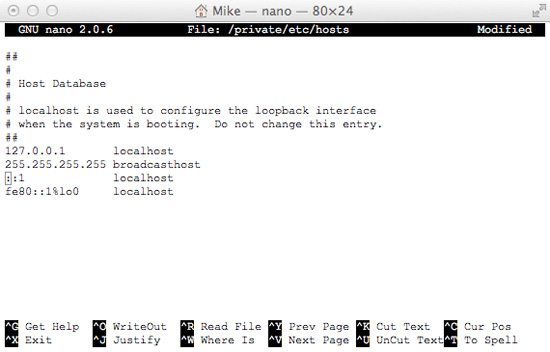

- #Edit osx host file adobe how to#
- #Edit osx host file adobe mac os x#
- #Edit osx host file adobe software#
- #Edit osx host file adobe code#
- #Edit osx host file adobe series#
Using “127.0.0.1” has caused issues of listens on TCP ports from hostile sites due to a OS X bug. Use the “Open File by Name” under the File menu.Īlso it’s advised to use “0.0.0.0”(nothing) instead of “127.0.0.1” (your computer) when blocking your computer from a website.
#Edit osx host file adobe software#
Text Wrangler (free) from Bare Bones Software will edit the /etc/hosts file with admin privileges no sweat. Sudo dscl localhost -delete /Local/Default/Hosts/foobar.localĪnd of course, if you want to list your entries:ĭscl localhost -list /Local/Default/Hosts Sudo dscacheutil -cachedump -entries Host You can then flush the cache to have it take effect:Īnd in case you were wondering what is in that cache, just to make sure it was cleared, or if you are having trouble, you can list the cache: Sudo dscl localhost -create /Local/Default/Hosts/foobar.local IPAddress 127.0.0.1 This would create foobar.local and point it to 127.0.0.1 To add a host with dscl, and skip /etc/hosts the syntax is pretty easy.
#Edit osx host file adobe code#
The hosts file is a fundamental to certain code routing aspects of your operating systems network.Īlso keep in mind, you can completely stop using /etc/hosts and use dscl to manage your hosts, which seems to be how Apple is moving forward in this regard. Look for the file named “hosts”, if it is not there, you have other issues, as your machine more or less needs it to work properly. You can list the directory and see if it is in there with: If you see a blank file, then you have the path incorrect, or there is no hosts file. You can now test your new mapping on the browser! On Leopard you can issue a simple Terminal command to flush the DNS cache, and have your host file changes to take immediate effect: $ dscacheutil -flushcache Press enter on the filename prompt, and control-x to exit the editor. When done editing the hosts file, press control-o to save the file. You can navigate the file using the arrow keys. Or edit one of the default values if you know what you are doing! Simply append your new mappings underneath the default ones. The hosts file contains some comments (lines starting with the # symbol), as well as some default hostname mappings (e.g. Open the hosts by typing on the Terminal that you have just opened: $ sudo nano /private/etc/hosts
#Edit osx host file adobe mac os x#
to redirect domains to local addresses.Įditing the hosts file in Mac OS X – Leopard, is a pretty easy task, especially if you are familiar with the terminal.Įither by start typing Terminal on the Spotlight, or by going into Applications -> Utilities -> Terminal. The hosts file can be edited to block certain hostnames (like ad-serving/malicious hosts), or used for web development purposes, i.e. Upon typing a url address on the browser, the system is checking if there is a relevant entry on the hosts file and gets the corresponding IP address, else it resolves the IP via the active connection’s DNS servers. * Link directly to the current version download page, as GitHub isn't easy to navigate if you're not familiar with it - you'd probably end up with a version to compile yourself, which is really not for beginners.The hosts file is a text file that maps hostnames to IP addresses. There's a save button at the top of the Gas Mask window. Repeat for anything else related to adobe - there may be a dozen lines or so.

#127.0.0.1 & that line will in future be ignored. You can delete the lines, but just in case you ever change your mind, a hash will stop that line from working. What you need to do is add a hash # to the beginning of each line you want to deactivate. This means any request by your Mac to access will not leave your Mac, but be routed instead to "me"… which is really "nowhere".

Leave these first few lines alone, they are necessary.īelow these common entries are custom entries - they will probably all show 127.0.0.1 then a domain, such as etc. You'll notice that localhost is set to 127.0.0.1 This is known as a loopback address, meaning "route back to myself"… this is what we're going to be looking for. Any line preceded by a # will be ignored.īelow that are the 'standard' defaults of localhost, broadcast etc.
#Edit osx host file adobe series#
Do not change this entry.Īt the top are a series of instructions & information, all nicely tucked behind # hash signs. # localhost is used to configure the loopback interface When you launch it, it will ask for your admin password, so it has permission to edit this file for you.Īn untouched hosts file will look something like this:- # Just drop it into your Applications folder after download, there's no installation process.
#Edit osx host file adobe how to#
If you're not familiar with how to use Terminal or edit the Hosts file in vim, then by far the easiest way to do it is use the GUI editor, Gas Mask* a freeware editor which takes the 'pain' out of the whole process.


 0 kommentar(er)
0 kommentar(er)
